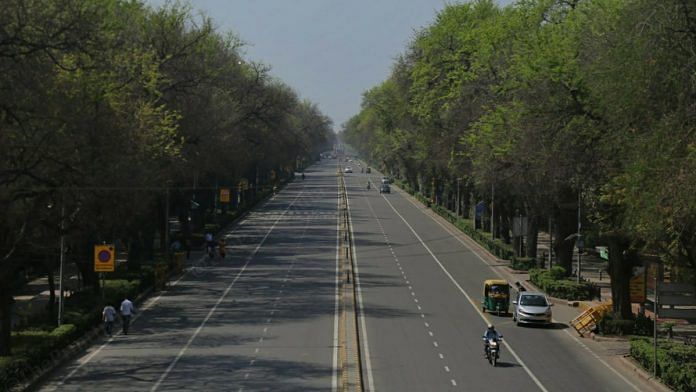New Delhi: Delhi’s particulate pollution levels went down drastically during the first three weeks of lockdown imposed in March-end to curb the spread of the coronavirus, but episodic high PM2.5 levels caused a haze to settle over the city just after dawn, according to a new study.
Scientists at JNU and Delhi University, who conducted the study, took advantage of the lockdown to assess the baseline levels of particulate matter and understand the meteorological conditions at low levels of pollution.
ThePrint has accessed the manuscript of the study, which will be published in the journal Scientific Reports on 10 August.
Delhi has been struggling with poor air quality, especially during the winter months. However, a complex mix of factors, including weather conditions, industrial and vehicular emissions, as well as burning of crop stubble in the months of October and November, has complicated policy decisions around solving the problem of air pollution in the national capital.
Now, for the first time, scientists have been able to observe the interplay of meteorological conditions and low levels of pollutants at a time when industrial and vehicular emissions as well as biomass burning were at the minimum.
A.P. Dimri, a JNU professor who was a part of the study, noted that at the beginning of the lockdown, social media was flooded with people claiming that lower levels of pollution improved visibility, allowing people to see faraway mountain peaks.
“We decided quickly — as soon as lockdown was announced — that we should start recording the observations because it would be invaluable,” Dimri told ThePrint.
“In normal times, we cannot stop vehicular pollution and industry. But nature gave us this unusual opportunity (to study the baseline levels of pollution) — it is like a natural laboratory,” he said.
Also read: India’s dirty air has become cleaner after coronavirus lockdown
Surface ozone levels remained high
The team, which also included researchers from Japan, collected pollution level data from Central Pollution Control Board, Delhi Pollution Control Committee and CUPI (Compact and Useful PM2.5 Instrument) from 8 monitoring stations in Delhi during the first three weeks of the lockdown and compared them to the data before the lockdown.
The study found that the PM2.5 levels reduced drastically by upto 70 per cent in the first three weeks since the lockdown was imposed from 25 March. But surface ozone levels remained high during the lockdown.
“It is possible that lower levels of nitrogen oxides in the air increased the ozone pollution level in the air,” Dimri told ThePrint.
He added that the team is now working on understanding the chemistry that would explain the high levels of surface ozone during the lockdown.
Although the overall PM2.5 levels went down, the scientists found that during the early hours of the morning, there was a significant jump in the PM2.5 levels, leading to haze formation.
The professor said that this is an ‘exciting’ finding, suggesting that moisture evaporating from the ground and trees make fine dust particles, which then aggregate to form particulate matter of 2.5 micron level.
“In the month of March, the temperature touches 30 degrees. It is very unusual to have fog and mists at that time. But the relatively clean atmosphere counter-intuitively allowed this fog to form,” he said.
This means that usual pollutants in the month of March made the atmospheric conditions such that it led to the formation of haze.
PM2.5 levels jumped to over 100 mg/m3 after dawn
The haze, however, quickly dissipated within two to three hours as the sun rose, bringing the PM2.5 levels to 15 to 20 microgram per cubic metre. In the early hours of the morning, the PM2.5 levels would jump up to over 100 to 150 microgram per cubic metre.
In the winter, when Delhi experiences the worst of pollution, a thick haze becomes a daily feature.
This research showed that the periodic formation of haze in the morning hours might not be strictly due to any episodic burning of crop stubble, and pollution from vehicles, industry or construction sites.
There has also been rainfall in many areas in Delhi, which was again unusual for March, Dimri said. So this study helps us see the meteorological conditions in the absence of pollution, he added.
Also read: How drop in pollution is giving social media users a clearer India to show off



